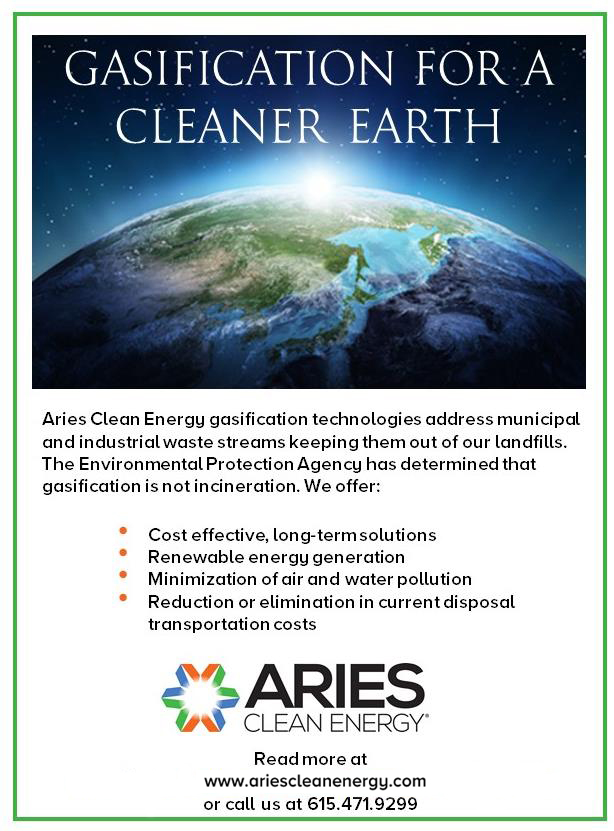Source
Aries Clean Energy
Publication Date
April 18, 2018
This year, The Earth Day Network is focusing on eliminating single-use plastics to lessen overall plastic pollution, and Aries Clean Energy is focusing its technologies on addressing solid waste diversion solutions to eliminate landfill usage.

Earth Day Network (EDN), the organization that leads Earth Day worldwide, announced that Earth Day 2018 (April 22) will focus on mobilizing the world to End Plastic Pollution, including creating support for a global effort to eliminate single-use plastics along with global regulation for plastic disposal. EDN’s goal is to educate millions of people about the health and other risks associated with the use and disposal of plastics, including pollution of the oceans, water, and wildlife, and about the growing body of evidence that decomposing plastics are creating serious global problems.
EDN’s goals include ending single-use plastics, promoting alternatives to fossil fuel-based materials, promoting 100 percent recycling of plastics, corporate and government accountability and changing human behavior concerning plastics.
A recent, related story on straw reduction can be found at
https://www.edie.net/news/5/McDonald-s-unveils-plan-to-phase-out-plastic-straws/
10 Shocking Facts About Plastic Pollution
https://www.earthday.org/2018/03/07/fact-sheet-end-plastic-pollution/
Earth Day organizers have published the following facts about plastic pollution.
Plastic pollution is choking the oceans, poisoning the food and water supply, and wreaking havoc on the health and well-being of humans and wildlife worldwide.
EDN suggests that you use these 10 shocking facts about the scope of plastic pollution to educate, inspire and mobilize your friends, family, coworkers and community to join the movement to END PLASTIC POLLUTION this Earth Day, April 22.
Fact 1 – 8.3 billion metric tons (9.1 billion US tons) of plastic has been produced since plastic was introduced in the 1950s. [1] The amount of plastic produced in a year is roughly the same as the entire weight of humanity. [2]
Fact 2 – Virtually every piece of plastic that was ever made still exists in some shape or form (with the exception of the small amount that has been incinerated). [3]
Fact 3 – 91% of plastic waste isn’t recycled. And since most plastics don’t biodegrade in any meaningful sense, all that plastic waste could exist for hundreds or even thousands of years. [4]
Fact 4 – 500 MILLION plastic straws are used EVERY DAY in America. That’s enough to circle the Earth twice. [5]
Fact 5 – Nearly TWO MILLION single-use plastic bags are distributed worldwide every minute. [6]
Fact 6 – 100 BILLION plastic bags are used by Americans every year. Tied together, they would reach around the Earth’s equator 773 times! [6]
Fact 7 – ONE MILLION plastic bottles are bought EVERY MINUTE around the world — and that number will top half a TRILLION by 2021. Less than half of those bottles end up getting recycled. [7]
Fact 8 – 8 MILLION METRIC TONS of plastic winds up in our oceans each year. That’s enough trash to cover every foot of coastline around the world with five full trash bags of plastic … compounding every year. [8]
Fact 9 – There is more microplastic in the ocean than there are stars in the Milky Way. [9]
Fact 10 – If plastic production isn’t curbed, plastic pollution will outweigh fish pound for pound by 2050. [10]
References/Citations:
[1] Science Advances, http://advances.sciencemag.org/content/3/7/e1700782
[2] The Guardian, https://www.theguardian.com/environment/2017/jun/28/a-million-a-minute-worlds-plastic-bottle-binge-as-dangerous-as-climate-change
[3] Science Advances, http://advances.sciencemag.org/content/3/7/e1700782
[4] National Geographic, https://news.nationalgeographic.com/2017/07/plastic-produced-recycling-waste-ocean-trash-debris-environment
[5] National Park Service, https://www.nps.gov/commercialservices/greenline_straw_free.htm
[6] Earth Policy Institute, http://www.earth-policy.org/press_room/C68/plastic_bags_fact_sheet
[7] The Guardian https://www.theguardian.com/environment/2017/jun/28/a-million-a-minute-worlds-plastic-bottle-binge-as-dangerous-as-climate-change
[8] Science Advances, http://advances.sciencemag.org/content/3/7/e1700782
[9] United Nations, https://news.un.org/en/story/2017/02/552052-turn-tide-plastic-urges-un-microplastics-seas-now-outnumber-stars-our-galaxy#.WLA81BLyvBJ
[10] World Economic Forum Report, http://www3.weforum.org/docs/WEF_The_New_Plastics_Economy.pdf
Other Earth Day Resources
What can I do – what can my company do – how to take action
EDN recommends several ways in which individuals or organizations/companies can be part of the goal for Earth Day. It suggests:
Get Involved – join the movement – https://www.earthday.org/take-action/
Give to the cause – help support the movement – https://www.earthday.org/take-action/
Spread the word – stay connected via social media

Twitter
https://twitter.com/EarthDayNetwork

Facebook
https://www.facebook.com/EarthDayNetwork/

You Tube
https://www.youtube.com/user/earthdaynetwork
History of Earth Day
This link will take you to a program that focuses on the history of Earth Day. From June 30, 1948: The Postwar Period to April 22, 1990 – the 20th anniversary of Earth Day.
http://www.pbs.org/wgbh/americanexperience/features/earth-days-modern-environmental-movement/
The First Earth Day
http://www.pbs.org/wgbh/americanexperience/features/earth-days-first-earth-day/


